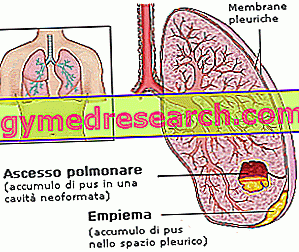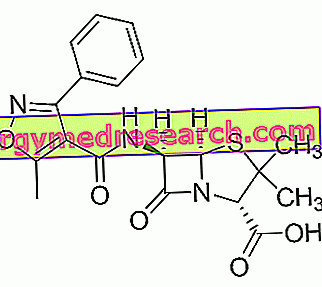What is the empiema?
The term "empyema" identifies any generic accumulation of purulent fluid (rich in pus) within a PRE-formed body cavity. The empyema must therefore be distinguished from the abscess, which consists in the accumulation of purulent material inside a NEO-formed cavity.

Causes
The pleural empyema - otherwise known as pyothorax - outlines a collection of pus in the pleural cavity, the space interposed between the lung and the inner surface of the chest wall.
The empyema can be circumscribed in a precise portion of the pleural cavity or involve the entire cavity.
The pathogenesis of the pleural empyema may be related to several causal elements:
- sub-phrenic / pulmonary abscesses
- infections (bacterial, parasitic and nocosomal) from pulmonary laceration, propagation of pathogens by lymphatic / hematic / trans-diaphragmatic route
- surgical interventions
- esophageal perforation
- sepsis
- superinfection of an hemothorax (presence of blood in the pleural fluid) initially sterile
- tuberculosis
Often the pleural empyema is described as a complication of infections with Streptococcus pneumoniae (pneumonia): in similar circumstances, pleural affection assumes the most precise connotation of meta-pneumonic empyema . The pulmonary abscess is also one of the most frequent etiopathological elements involved in the empyema.
Only in rare cases, the empyema may be the consequence of thoracentesis, a diagnostic practice aimed at taking a sample of pleural fluid using a needle inserted directly into the pleural cavity.
The pathogens most involved in the manifestation of the empyema are Staphylococcus aureus, streptococci, gram-negative bacteria ( Klebsiella pneumoniae, Escherichia coli, Proteus, Salmonella, Acinetobacter baumannii ), anaerobes (Bacteroides) and parasites (Paragonimus).
Symptoms
The symptoms, as well as their intensity, depend on the severity of the empyema. In general, patients admitted with empyema complain of asthenia, chills, weight loss, dyspnoea, chest pain, fever, malaise and cough. Chest pain is exacerbated by deep breaths and coughing.
In the vast majority of diagnosed empyries, a constant trend of the disease was observed, distinguishable in three phases:
- Exudative phase of the empyema (acute empyema). This phase lasts about two weeks and is characterized by an exudative inflammation with poor fibrin synthesis. The pleural fluid is not very dense and has few cells. Only an immediate and specific antibiotic therapy intervention carried out at this stage can ensure a complete return to integrum .
- Fibrino-purulent phase of empyema (frank empyema): after the first 14 days from the onset of the empyema, the second phase begins, in which an enormous quantity of polymorphonuclear granulocytes, bacteria and necrotic material is produced, associated with a conspicuous fibrin deposition. The co-presence of these substances favors the chronicization of the empyema. This phase begins during the third week of the onset of the condition, ending after 14 days.
- Organizational phase (chronic empyema): constitutes the last stage, in which the visceral pleura is fixed with the parietal one, until forming a sort of resistant skin or shell that encloses the lung, limiting its mechanics.
Due to an inflammatory and fibrous reaction, the pleura that delimits the empyema thickens excessively and becomes inelastic: by doing so, the lung is denied the possibility of re-expanding.
Complications
To minimize the risk of complications, antibiotic therapy should start from the earliest symptoms, therefore during the exudative phase of the empyema. A delayed therapy can favor the onset of complications:
- spread of infection
- broncho-pleural fistulas: the purulent material which is not evacuated by surgical intervention can drain spontaneously into the bronchial side, with the consequent appearance of foul-smelling purulent sputum
- fibrothorax: clinical condition characterized by the reduction of amplitude, expansibility and parietal elasticity of the hemithorax. It follows a functional damage with severe restrictive ventilatory deficit.
- sepsis: alarming and exaggerated Systemic Inflammatory Response (SIRS), sustained by the body following a bacterial insult
- empiema necessitatis: clinical condition in which the pus is collected under the skin and fistula outside the chest. This form of empyema is a typical complication of Mycobacterium tubercolosis infections.
Diagnosis
The diagnosis of pleural empyema is ascertained when the quantity of leukocytes in the pleural fluid is greater than at least 15, 000 units per mm3 and the presence of microorganisms in situ is detected.
Routine diagnostic techniques include:
- chest x-ray
- CT of the chest
- Culture test after thoracentesis
From the diagnostic results, the pleural purulent fluid has peculiar biochemical characteristics, shown in the table.
Parameter | Indicative value |
pH | <7.20 |
Pleural LDH | > 200 U / dl |
Pleural LDH / serum LDH | > 0.6 |
Glucose | <40-60 mg / dl |
leucocytosis | 15, 000-30, 000 polymorphonuclear leukocytes (PMN) / mm3 |
Pleural liquid proteins | > 3g / dl |
Care
The main goal of treatment for empyema is twofold. On the one hand it is necessary to remove the bacterium or in any case the pathogen with an appropriate pharmacological treatment (antibiotic), on the other it is essential to constantly evacuate the purulent material that accumulates in the pleural cavity.
Pending the results of the antibiogram, it is recommended to start the treatment by administering aminoglycoside antibiotics such as gentamicin and tobramycin, associated with a broad spectrum penicillin.
The therapy of empyema depends on the stage of evolution in which the condition is diagnosed.
If in the initial stage the thoracentesis and the antibiotic therapy are sufficient for the complete recovery of the patient, in the later stages of the empyema the therapy is more complex. Starting from the third week after the onset of symptoms (phase II), the doctor must subject the patient to closed drainage, clearly always associating the antibiotic treatment. Stage III, the most dangerous, requires pleural decortication, which consists in removing the visceral pleura.
The prognosis depends on when the antibiotic treatment is started and the purulent fluid is removed. Before the entry of antibiotics into therapy, mortality related to empyema was considerably higher.



